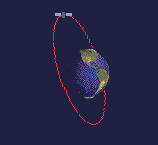![]()
This orbit is a special case of the polar orbit. Like a polar orbit, the satellite travels from the north to the south poles as the Earth turns below it. In a sun-synchronous orbit, though, the satellite passes over the same part of the Earth at roughly the same local time each day. This can make communication and various forms of data collection very convenient. For example, a satellite in a sun-synchronous orbit could measure the air quality of Ottawa at noon.

There is a special kind of sun-synchronous orbit called a dawn-to-dusk orbit. In a dawn-to-dusk orbit, the satellite trails the Earth's shadow. When the sun shines on one side of the Earth, it casts a shadow on the opposite side of the Earth. (This shadow is night-time.) Because the satellite never moves into this shadow, the sun's light is always on it (sort of like perpetual daytime). Since the satellite is close to the shadow, the part of the Earth the satellite is directly above is always at sunset or sunrise. That is why this kind of orbit is called a dawn-dusk orbit. This allows the satellite to always have its solar panels in the sun.
Generally, sun-synchronous orbits are medium or low orbits.
Radarsat is an example of a satellite in a low sun-synchronous orbit. Radarsat is in orbit 798 kilometres above the Earth, at an angle of inclination of 98.6 degrees to the equator as it circles the globe from pole to pole. Radarsat relies on its dawn-to-dusk orbit to keep its solar panels facing the sun almost constantly. Radarsat can therefore rely mostly on solar power and not on batteries.